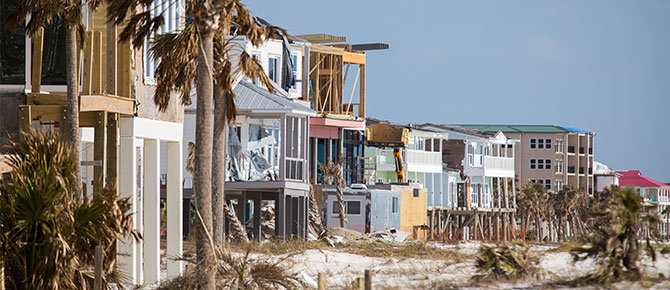At Dewberry, we pride ourselves on being a “national firm with a community-based practice.” I’ve never seen that so clearly put into practice as I did following the devastation of Hurricane Michael in the fall of 2018. The Category 5
storm swept through the Florida Panhandle, devastating thousands of square miles with its 160 mile per hour wind speeds and fourteen-foot storm surge. Five of our offices lay in the storm’s path, including Port St. Joe, Blountstown, Panama City,
Bonifay, and Tallahassee. With nearly 80 employees across these locations, we’re thankful to be able to say that all survived the storm, although many experienced severe damage to their personal property, and some offices saw major damage. Our
employees didn’t band together on just a local level, but as firm, nationwide, employees from across the country worked to support our Florida Panhandle team by donating funds and personal leave hours, sending condolences and prayers, and offering
to support workload as we picked up the pieces. Some of our employees lost everything, yet they were welcomed in by other staff who supported them and their families through one of the most tragic experiences.
We talk a lot about how we’re community based, our projects are great examples—we design schools and public safety facilities, and roads and bridges; we engineer parks, community centers, and local hospitals—but nothing compares to the
community support of fellow employees. While our corporate organization is focused on communities across the country, they’re also focused on the people who work in those communities—their employees.

Utilizing Damage Assessments to Expedite Funding
Additionally, our firm utilized its team of planners, engineers, resilience experts, and geographic information systems (GIS) specialists to help the Panhandle assess damage and begin the road to recovery.
Through a pilot study, we worked with a 3D imagery collection company to utilize their imagery for identifying and estimating the volume of debris generated by the storm. Rapid analytics were performed on the imagery to determine debris quantity and type,
damaged residences with debris brought to the right-of-way for collection, and visualization of areas with dense groupings of different debris types. This information was used to determine:
- Where, when, and what type of debris clearance and collection crews should be dispatched, and in what quantities
- If residents were adequately segregating their debris at the right-of-way for efficient collection
- Should additional outreach of debris staging instructions have been be disseminated
- How much of each type of debris could be expected
- And if temporary debris management sites were warranted given the anticipated volumes of debris
Unfortunately, Hurricane Michael was not the only natural disaster to affect the U.S. in late 2018 and early 2019. Hurricane Florence devastated parts of North and South Carolina, and the California Wildfires destroyed thousands of acres. However, with
the results of the damage assessments produced from the Hurricane Michael pilot study, we were able to help the Federal Emergency Management Agency provide additional support to areas affected by Hurricane Florence and the California Wildfires.
Continuing to Recover and Rebuild
Today, our staff and community members continue to rebuild. While some people are back to normal life—or have redefined their sense of normalcy—others are still in that process. Dewberry continues to support
staff members and the Florida Panhandle community. Our clients have resumed operations or are close to doing so completely, and we’re here to help them. Storms can knock you—or an entire community—down, but comradery picks them back
up.